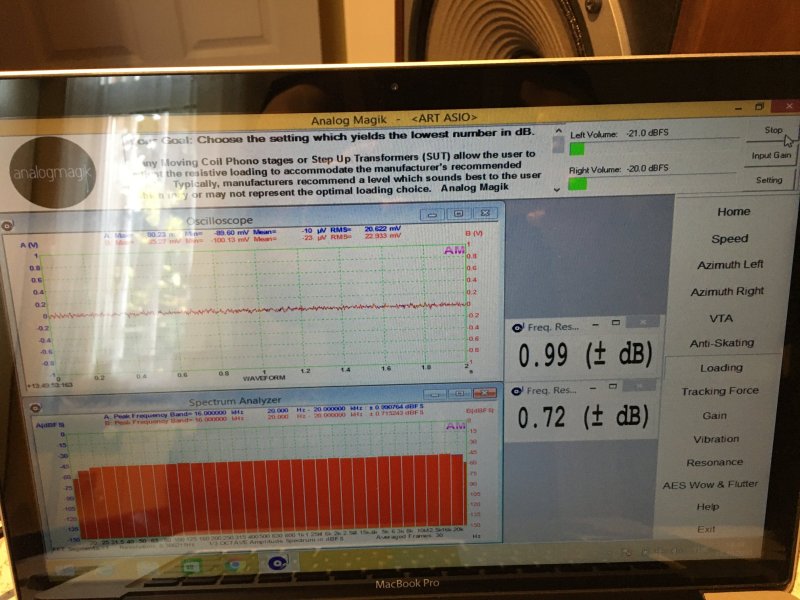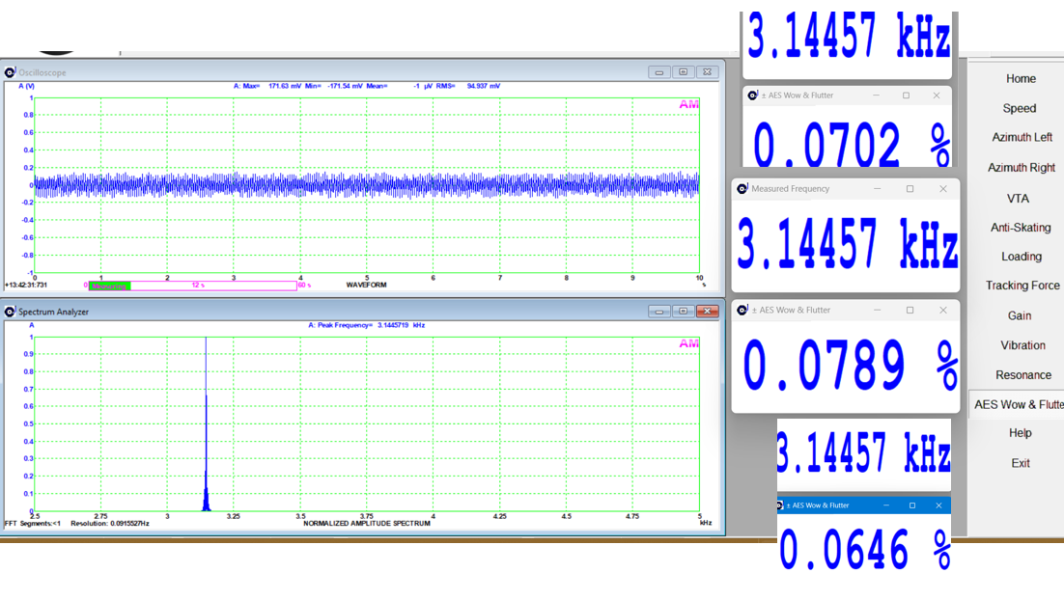Actually the aim is updated on version 2. Now it's recommended to do as I explained.This part (which I agree with) seems to be in direct conflict with the AM video, indicating that optimal azimuth when using their record and software is achieved when the L and R crosstalk values are as close together as possible.
Analog Magik
- Thread starter Tirebiter
- Start date
You are using an out of date browser. It may not display this or other websites correctly.
You should upgrade or use an alternative browser.
You should upgrade or use an alternative browser.
Yes, I have seen this in my AM v2 software instructions, but the website still talks about close channel balance numbers. At best it’s misleading. Look on this pageActually the aim is updated on version 2. Now it's recommended to do as I explained.
How to set Azimuth and VTA together using 1 test track
What is Azimuth, VTA/SRA and how to set Azimuth on turntable setup. Vertical Tracking Angle and Stylus Raking Angle.
 www.analogmagik.com
www.analogmagik.com
The third paragraph under Interpreting Results. For those unlike us, who don’t have the software in hand and in use, it can be a little confusing.
Last edited:
Thanks all for such a great conversation....
Let us remember that when we do these test record comparisons ....
If we start with our azimuth or zenith cartridge setting [Alignment] out of spec [as we do not know what the actual perfect was / is] then we are getting readings from the LP's based upon the out configuration and that one LP may show our out as being great because the LP has compensated for our error....thus we are even further chasing our tails to nowhere ....
Let us remember that when we do these test record comparisons ....
If we start with our azimuth or zenith cartridge setting [Alignment] out of spec [as we do not know what the actual perfect was / is] then we are getting readings from the LP's based upon the out configuration and that one LP may show our out as being great because the LP has compensated for our error....thus we are even further chasing our tails to nowhere ....
My results with Denon 51F and Shure V15-IV JicoSAS B stylus

 audiosciencereview.com
audiosciencereview.com
in menu order nor track order.

1. Speed

2. Azimuth tilted compared with my chosen reference Toshiba 37/37 and Ortofon slighly off , who knows which one is correct,,,


3.VTA 60hz 7000Hz intermodulation track stereo Shure V15 gives 7-8% while AT OC9MLii gives 2-4%

4. Antiskating, standard 315Hz track increasing level I get balanced results that are supposedly good, OC9 lower than Shure/Jico thd%

5.Loadin g=frequency respnonse, too wide scale I think.. her my Shure which is very flat

In REW it looks like this on OC9

6. VTF 300 and 7000Hz tones and distortion evaluation, I got no effect on distortion when varying VTF

7. Gain Noise floor evaluation, I got this at 39db Gain on MM. Nice balance on this cart 0.1db. I think 30db noise floor means 50db noisefloor at 1khz

8. Intermodulation test 60/500HZ to revieal vibration?, Numbers go up if i bump the TT... her is Denon DP-51F which is not very inert...

9. Resonance test lateral and vertical, but range is 7.5-35Hz should go down to 5 at least to be useful... My Denoen 51F has electronic arm damping and hides resonances well


Fun with vinyl measurements
The speed fluctuation is about two percent, what kind of records it (Lyrec motor) could be used for cutting, gramophone?
 audiosciencereview.com
audiosciencereview.com
in menu order nor track order.
1. Speed
2. Azimuth tilted compared with my chosen reference Toshiba 37/37 and Ortofon slighly off , who knows which one is correct,,,

3.VTA 60hz 7000Hz intermodulation track stereo Shure V15 gives 7-8% while AT OC9MLii gives 2-4%
4. Antiskating, standard 315Hz track increasing level I get balanced results that are supposedly good, OC9 lower than Shure/Jico thd%
5.Loadin g=frequency respnonse, too wide scale I think.. her my Shure which is very flat
In REW it looks like this on OC9
6. VTF 300 and 7000Hz tones and distortion evaluation, I got no effect on distortion when varying VTF
7. Gain Noise floor evaluation, I got this at 39db Gain on MM. Nice balance on this cart 0.1db. I think 30db noise floor means 50db noisefloor at 1khz
8. Intermodulation test 60/500HZ to revieal vibration?, Numbers go up if i bump the TT... her is Denon DP-51F which is not very inert...
9. Resonance test lateral and vertical, but range is 7.5-35Hz should go down to 5 at least to be useful... My Denoen 51F has electronic arm damping and hides resonances well
Last edited:
Great present....lucky...
Test Software of AM with some of your other records to get another base for readings........it will show again how many differences with different LP's
Even differences with other pressings of AM lp's [compare the 33 with 45]
I have both V1 and V2.......huge differences in Azimuth .....as well as many other test LP's showing figures all over the place.....
Test Software of AM with some of your other records to get another base for readings........it will show again how many differences with different LP's
Even differences with other pressings of AM lp's [compare the 33 with 45]
I have both V1 and V2.......huge differences in Azimuth .....as well as many other test LP's showing figures all over the place.....
IMHO, @Balle Clorin, your results are promising. You can adjust zenith using VTA track concentrating on the numbers at the beginning and how they change. Additionally I’m expecting to see the wow&flutter measurements cause this one uses AES and it’s more reliable than others in my opinion.
Indeed. The Azimuth xtalk on the 45rpm record are within 1db… quite different from the 33rpmGreat present....lucky...
Test Software of AM with some of your other records to get another base for readings........it will show again how many differences with different LP's
Even differences with other pressings of AM lp's [compare the 33 with 45]
I have both V1 and V2.......huge differences in Azimuth .....as well as many other test LP's showing figures all over the place.....
Here are some measurements I made with AM version 1 (Benz cartridge, SME tonearm, Verdier turntable, Kondo electronics and cables)
VTA at the beginning of the track

At the end of VTA track. You can see the flat line on oscilloscope window. It should not exceed %3 IMD throughout the track but it’s not easy with a used cartridge.

Azimuth (this is the only adjustment I use AP test disc instead of AM).

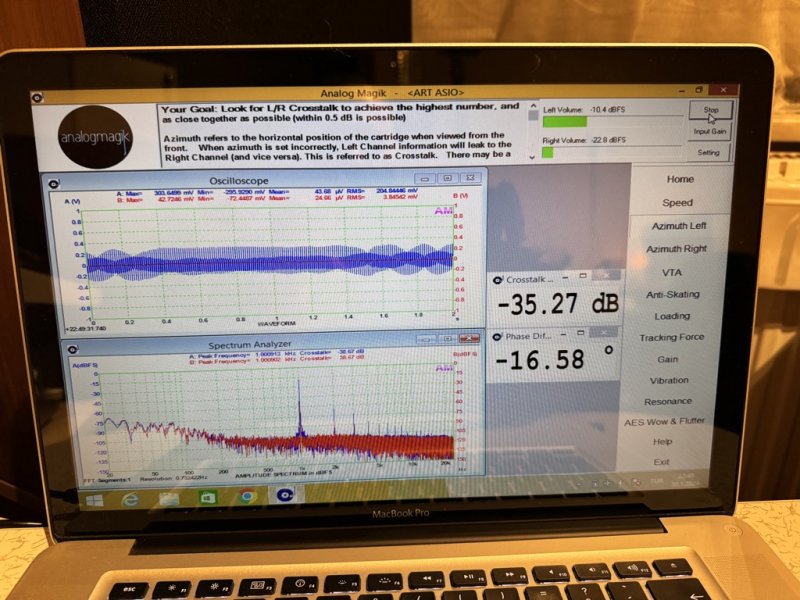
Anti-skating at the beginning of the track
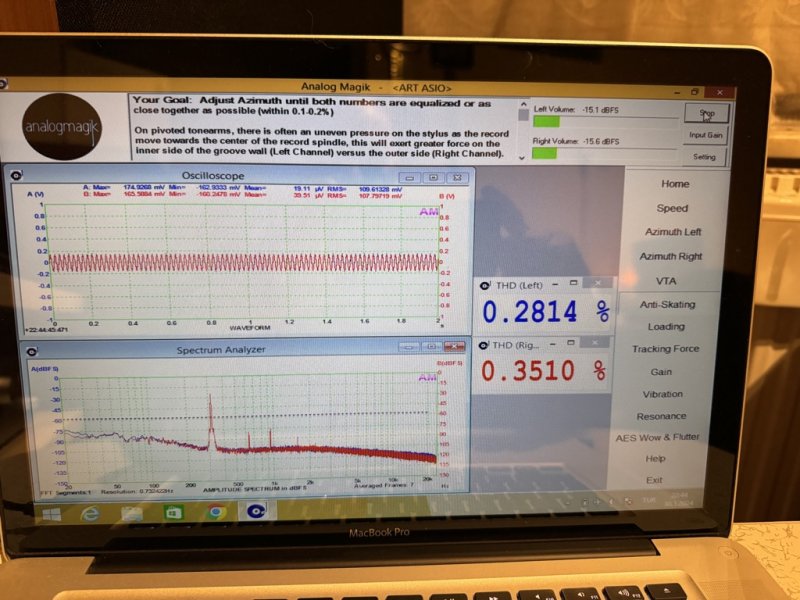
In the middle
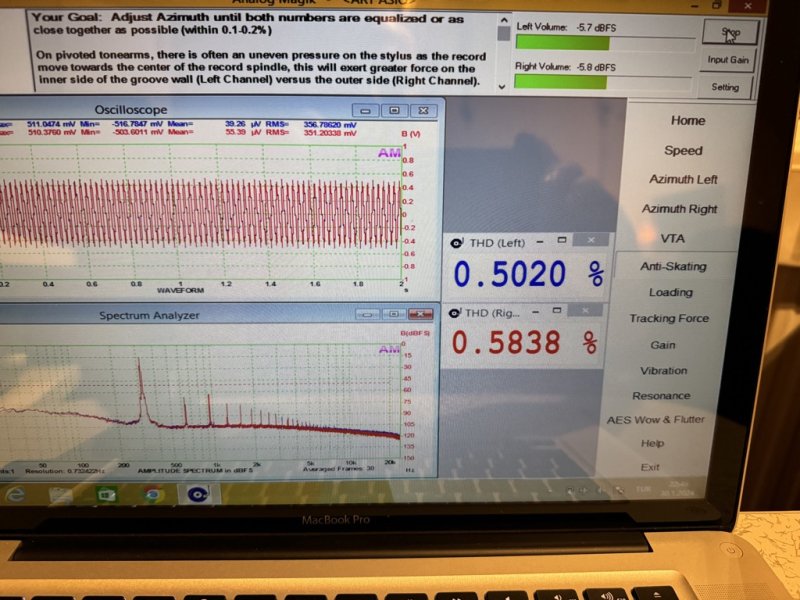
At the end. It should not exceed %1 and channels should be in %0.2

Resonance. There should be a peak between 8-12Hz with a clean looking graph.
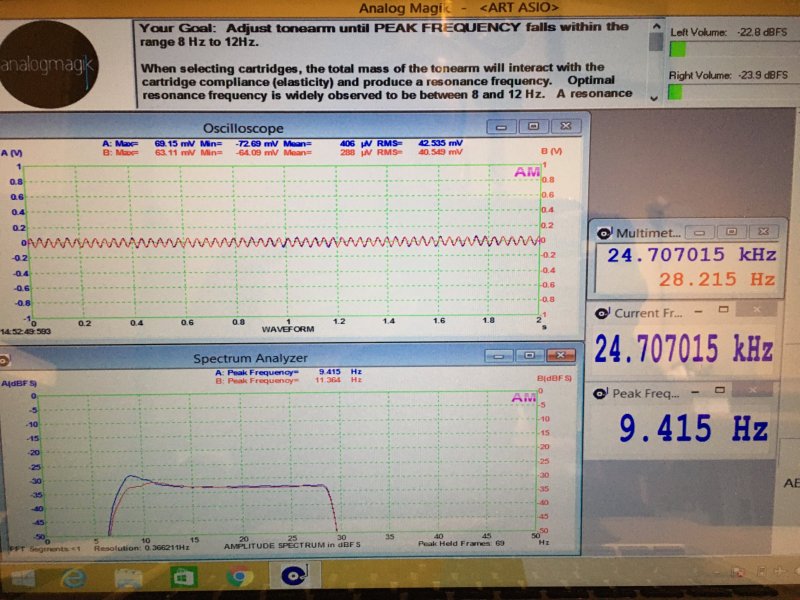
Loading. (Not a very meaningful adjustment)
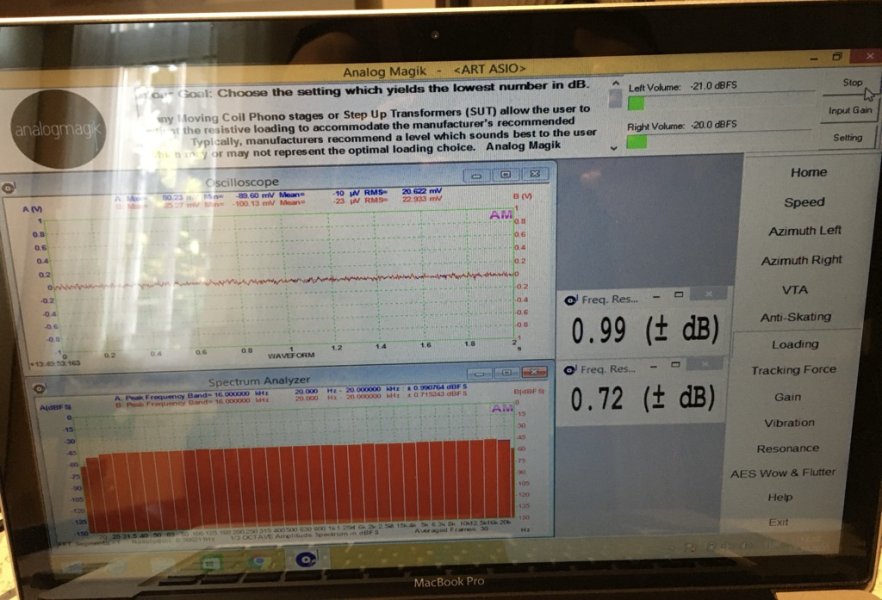
I’ll load wow&flutter measurements later.
VTA at the beginning of the track

At the end of VTA track. You can see the flat line on oscilloscope window. It should not exceed %3 IMD throughout the track but it’s not easy with a used cartridge.

Azimuth (this is the only adjustment I use AP test disc instead of AM).


Anti-skating at the beginning of the track

In the middle

At the end. It should not exceed %1 and channels should be in %0.2

Resonance. There should be a peak between 8-12Hz with a clean looking graph.

Loading. (Not a very meaningful adjustment)

I’ll load wow&flutter measurements later.
Attachments
Last edited:
Yes I read about that Zenith trick, but I do not see A reliable trend. Maybe I am near the optimum. In fact if anything the 45 record responds differently than the 33 on the VTA.IMHO, @Balle Clorin, your results are promising. You can adjust zenith using VTA track concentrating on the numbers at the beginning and how they change. Additionally I’m expecting to see the wow&flutter measurements cause this one uses AES and it’s more reliable than others in my opinion.
Wow and Flutter Tracks not great, but OK compared to many, my B&K QR2010 is significantly better. 45 rpm has a very recognizable pattern 8 times per revolution that is not visible on the 33rpm..
The resonance tracks should have started from 5Hz not 7.5 in my option.
Which cartridge did you post above please?seems to be very nice
Last edited:
It’s a great track. The reason you get worse numbers compared to other measurement methods is the integration time of AES standard incorporated with AM. If you can get a better test record it’s even better. What are the wow&flutter results you get with AM V1 test disc?Wow and Flutter Tracks not great, but OK compared to many, my B&K QR2010 is significantly better. 45 rpm has a very recognizable pattern 8 times per revolution that is not visible on the 33rpm..
Last edited:
Regarding W&F I get at bout 0.07mowon the EAS value om the 33rpm record on my DD Denon 51F Multitone gived a bit worse 0.08wow
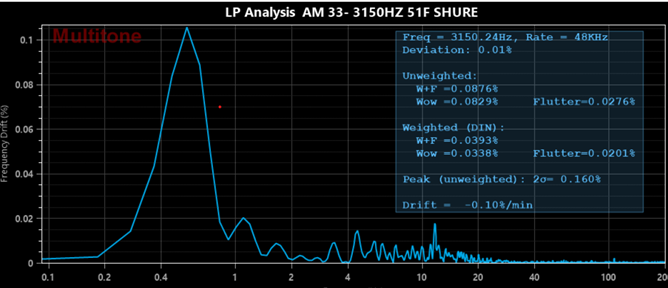
Comparing with my best 3150Hz record 0.0389%

Comparing B&K QR2010 and Analog Magik 33 rpm on Denon 51F DD. (Not same Y scale on blue plots)
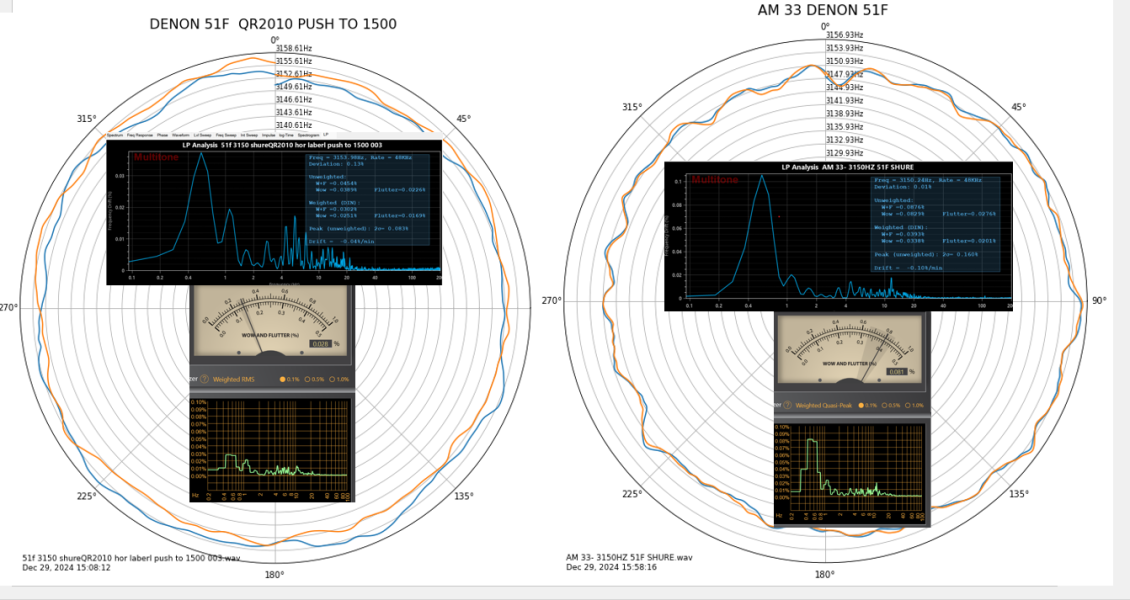
45RPM has a very noticable repeating pattern at 6Hz, 8 times per revolution. not sure if it is my TT 45 setting or AM 45 record.

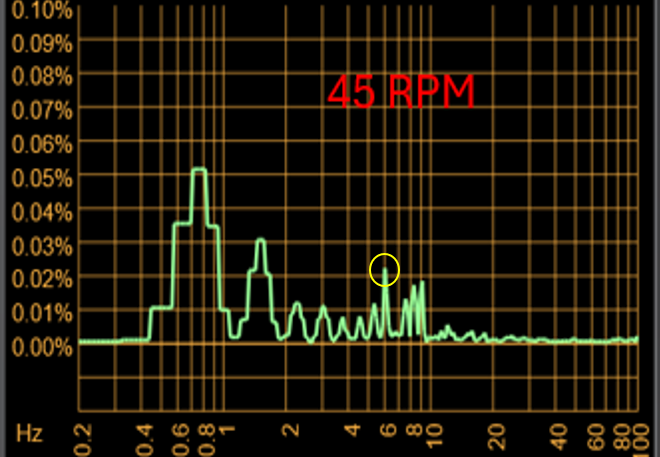

Comparing with my best 3150Hz record 0.0389%

Comparing B&K QR2010 and Analog Magik 33 rpm on Denon 51F DD. (Not same Y scale on blue plots)

45RPM has a very noticable repeating pattern at 6Hz, 8 times per revolution. not sure if it is my TT 45 setting or AM 45 record.


Last edited:
No, not those. What results do you get using AM V1 software and disc at 33.3rpm? That’s the one I’m asking.Regarding W&F I get at bout 0.07mowon the EAS value om the 33rpm record on my DD Denon 51F Multitone gived a bit worse 0.08wow
View attachment 142433
Comparing with my best 3150Hz record
View attachment 142432
Comparing B&K QR2010 and Analog Magik 33 rpm on Denon 51F DD. (Not same Y scale on blue plots)
View attachment 142431
45RPM has a very noticable repeating pattern at 6Hz, 8 times per revolution. not sure if it is my TT 45 setting or AM 45 record.
View attachment 142434
View attachment 142435
Please do not misdirect by sharing results from different software cause it’s not easy to corroborate. If don’t want to share it’s fine but I’m only asking because you posted about wow&flutter many times. Since you own a AM software finally we can meet at common ground.
It's ok for a direct drive at 45rpm. Most probably the result will be around %0.09 to %0.1 for 33.3rpm. Which means there is room for improvement. AM relies on AES standard and that's why results are worse than other measurement methods that rely on instant calculation. IMHO it's not a bad W&F measurement, the best I have measured around %0.04- %0.05.It values vary a bit but 0.07% as a mean value on Denon 51F 45rpm re4cord, have to redo the 33 record
View attachment 142436
BTW here is a measurement of my Technics SL-1000 mkII using an app but I don't consider smartphone apps as reliable.
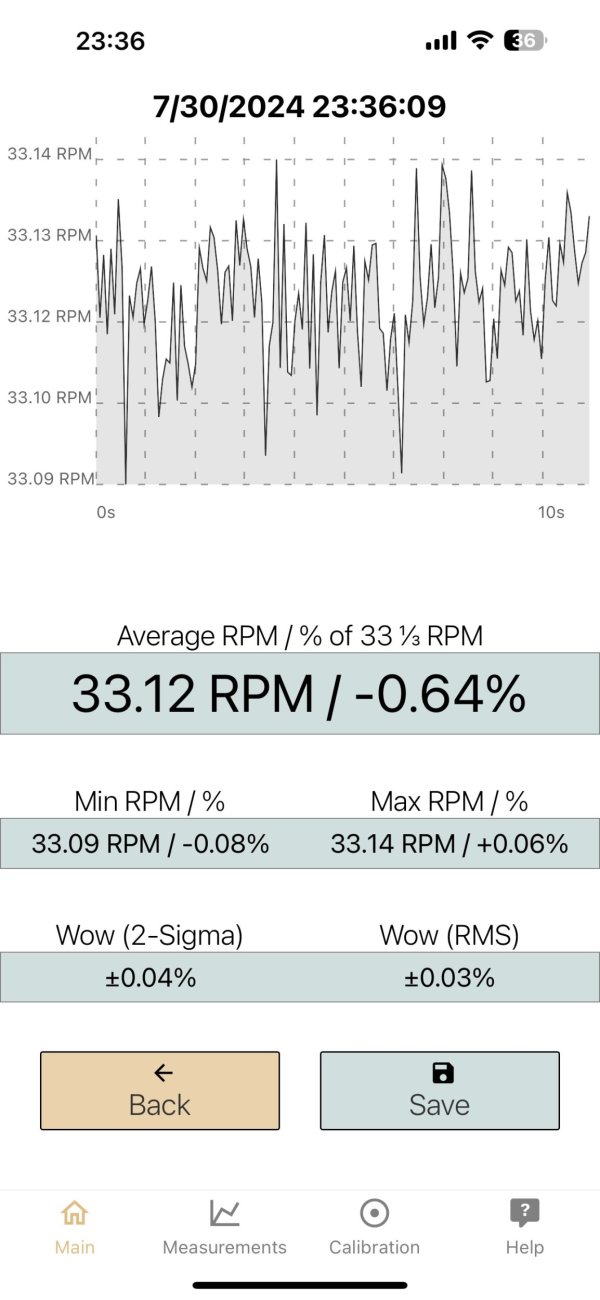
I used iphone 15 pro max for this, older phones may show better results IME. Speed is exactly 33.3rpm cause I checked it with AM. W&F with AM is %0.04 but I couldn't find the picture of it. WFGUI also gives better results. As I said before AM (AES) is the most reliable one among these W&F measurement methods in my opinion.
Obviously Technics 1200G doesn't perform well on W&F measurement nor most of the direct drives. IMO/IME only a handful of DD tables such as Technics SL-1000 and Exclusive P3 performs well, equal to best belt drives. Sound quality is another matter.I prefer this phone app for IPhone absolute speed is off by +0.24% but the variations are consistent with other measurements (Shaknspin ++)
This is the best I can get. It is on par with Technics 1200g
View attachment 142442
View attachment 142443
A lot of poor performers out there..".. but they look nice..
Post in thread 'Best turntable under 50k?'
https://www.whatsbestforum.com/threads/best-turntable-under-50k.35945/post-1011944
Post in thread 'Best turntable under 50k?'
https://www.whatsbestforum.com/threads/best-turntable-under-50k.35945/post-1011944
Last edited:
For an absolute speed I find a strobe disk and Quartz controlled led light to be the best reference . I use A project disk and the KAB light
A single W&F number can hide a lot of problems, I prefer to se a plot and patterns, see post 538
A single W&F number can hide a lot of problems, I prefer to se a plot and patterns, see post 538
Last edited:
Similar threads
| Steve Williams Site Founder | Site Owner | Administrator | Ron Resnick Site Owner | Administrator | Julian (The Fixer) Website Build | Marketing Managersing |







